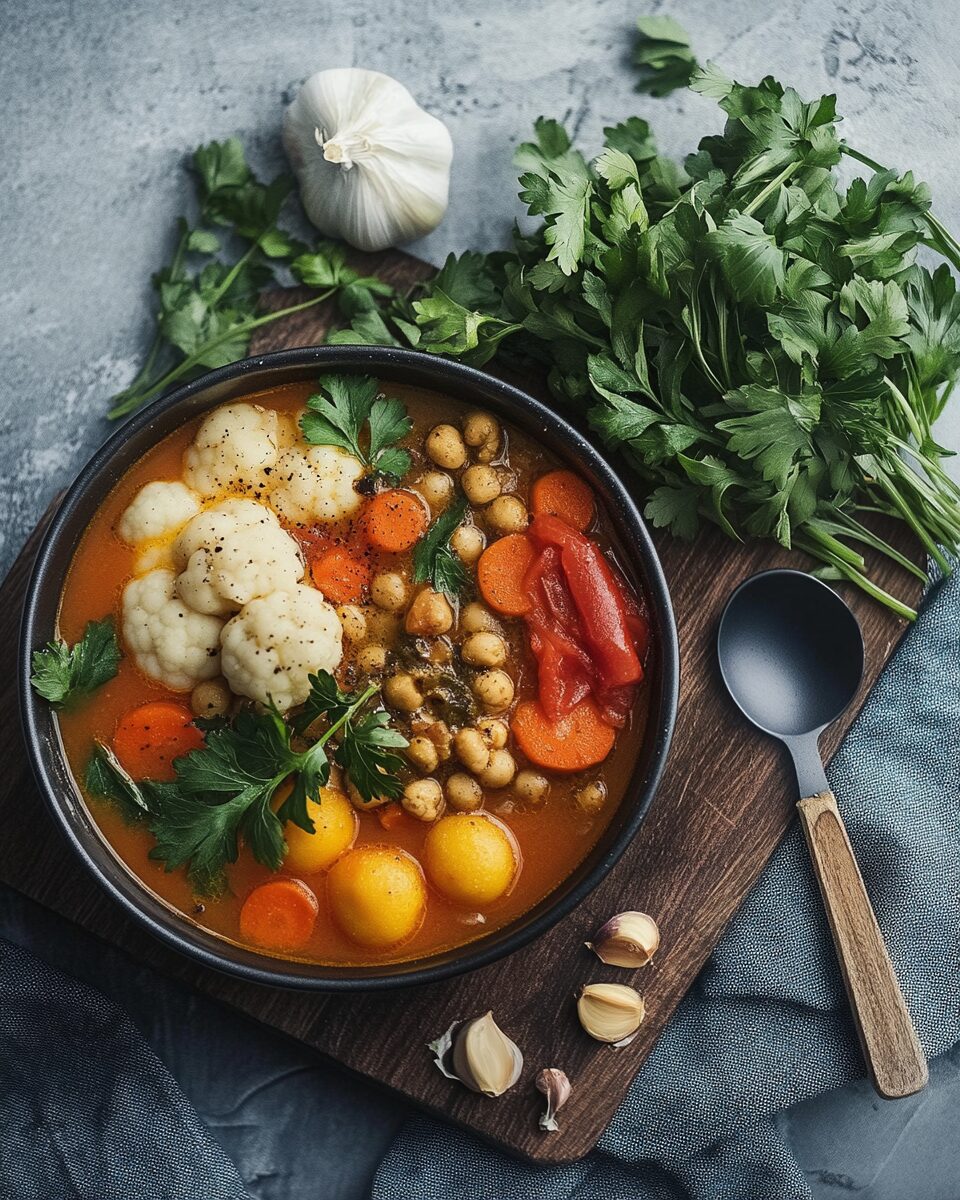Moroccan cuisine captivates the senses with vibrant colors, fragrant spices, and comforting textures. At its core, it features a beautiful balance of sweet, savory, and piquant flavors—something you’ll notice from your first spoonful of this Moroccan Vegetable Soup. It’s a warm, hearty dish that you can enjoy any time of year, though it’s especially inviting in chilly weather when all you want is something wholesome and nourishing. This soup involves bold spices, nutritious beans, colorful vegetables, and the delicate, earthy charm of quinoa, all simmered in a fragrant broth.
Full Recipe:
Ingredients
-
2 tablespoons olive oil
-
1 large onion, diced
-
3 cloves garlic, minced
-
2 carrots, peeled and chopped
-
2 celery stalks, chopped
-
1 red bell pepper, diced
-
1 zucchini, diced
-
1 cup canned chickpeas, drained and rinsed
-
1 cup canned diced tomatoes
-
6 cups vegetable broth
-
1/2 cup quinoa, rinsed
-
1 teaspoon ground cumin
-
1 teaspoon ground coriander
-
1/2 teaspoon ground turmeric
-
1/2 teaspoon ground cinnamon
-
1/4 teaspoon cayenne pepper (adjust to taste)
-
Salt and black pepper to taste
-
Fresh cilantro or parsley for garnish
-
Lemon wedges for serving
Directions
-
In a large pot, heat the olive oil over medium heat. Add the diced onion and sauté until translucent, about 5 minutes.
-
Add the minced garlic, carrots, celery, and red bell pepper to the pot. Cook for another 5 minutes, stirring occasionally.
-
Stir in the zucchini, chickpeas, diced tomatoes, and all the spices (cumin, coriander, turmeric, cinnamon, cayenne pepper). Cook for 2 minutes to allow the spices to become fragrant.
-
Pour in the vegetable broth and bring the mixture to a boil. Once boiling, add the rinsed quinoa.
-
Reduce the heat to low, cover the pot, and let the soup simmer for 15-20 minutes, or until the quinoa and vegetables are tender.
-
Season the soup with salt and black pepper to taste. Adjust the cayenne pepper if more heat is desired.
-
Ladle the soup into bowls and garnish with fresh cilantro or parsley. Serve with lemon wedges on the side for a bright, citrusy finish.
Nutrients
Per serving (based on 6 servings):
-
Calories: 180
-
Protein: 6g
-
Carbohydrates: 30g
-
Dietary Fiber: 6g
-
Sugars: 6g
-
Fat: 4g
-
Saturated Fat: 0.5g
-
Cholesterol: 0mg
-
Sodium: 600mg
-
Potassium: 550mg
-
Vitamin A: 80% DV
-
Vitamin C: 60% DV
-
Calcium: 6% DV
-
Iron: 15% DV
Cultural Origins and Significance
Moroccan Vegetable Soup draws inspiration from harira, a traditional Moroccan soup often enjoyed to break the fast during Ramadan. While harira typically includes meat and lentils, this vegetable version is adapted for a broader audience, catering to vegetarians and those seeking a lighter, cleaner meal.
The soup echoes the values of Moroccan hospitality. In Moroccan households, meals are more than just food—they are a shared experience filled with community, love, and time-honored customs. Soups like these are served in large bowls for the entire family to enjoy, often paired with freshly baked khobz (traditional Moroccan bread) or slices of lemon to add a tangy finish.
A Bowl of Balanced Nutrition
From a health perspective, Moroccan Vegetable Soup is a nutrient powerhouse. It features a medley of vegetables—onions, carrots, zucchini, and bell peppers—combined with protein-rich chickpeas and fiber-filled quinoa. This soup offers a wide spectrum of vitamins, minerals, and antioxidants while keeping the fat content low.
The inclusion of turmeric, cumin, coriander, and cinnamon not only enhances the flavor but also adds significant anti-inflammatory and digestive benefits. These spices have been studied for their role in supporting immune function, improving circulation, and balancing blood sugar levels.
What’s more, quinoa provides a complete source of protein, making this dish particularly satisfying for vegans and vegetarians. The vegetable broth serves as a low-calorie, hydrating base that ties everything together without weighing it down.
Flavor Profile and Aromatics
The success of this soup lies in its aromatic spice profile. Moroccan dishes are known for the layering of spices rather than heat. This soup achieves depth through warming spices like cumin, coriander, cinnamon, and turmeric, with a hint of cayenne to awaken the senses. Each spoonful carries subtle complexity, where no ingredient overshadows the others.
Aromatics such as onion and garlic form the base, sautéed until golden to release their sweetness and umami. Fresh herbs like cilantro or parsley are added at the end, brightening the soup with freshness and a pop of green. Lemon wedges are often served alongside to provide a zesty contrast that lifts the entire bowl.
Versatility and Customization
One of the greatest aspects of Moroccan Vegetable Soup is its versatility. This recipe welcomes modifications based on seasonal availability and personal preference. You can substitute or add vegetables such as sweet potatoes, kale, spinach, or green beans. The spice level can be adjusted for children or those sensitive to heat.
For extra richness, some may choose to stir in a spoonful of harissa (a North African chili paste) or coconut milk. Those who prefer a heartier texture may blend half the soup to create a thicker consistency while still leaving some chunks intact.
It’s also an excellent dish for batch cooking. The soup stores well in the fridge for several days and tastes even better the next day as the flavors continue to meld. It’s freezer-friendly, making it a great option for meal prep or serving unexpected guests with something homemade and wholesome.
Perfect for Any Occasion
This soup is appropriate for any time of the year, though it’s especially comforting in the fall and winter months. It works beautifully as a main course for lunch or dinner, or as a starter to a larger Moroccan-themed meal.
It’s also ideal for dinner parties or potlucks, offering a dish that feels both familiar and exotic. The vibrant colors and rich aroma make it a showstopper without requiring hours in the kitchen.
For a complete Moroccan-inspired menu, pair the soup with couscous salad, warm olives, and mint tea. Add crusty bread for dipping, and you’ve got a nourishing, flavorful spread that’s sure to impress.
Why It Appeals to a Modern Lifestyle
With the rise of plant-based eating and wellness-focused cooking, this Moroccan Vegetable Soup checks all the right boxes. It’s vegan, gluten-free, dairy-free, and easy to digest. It aligns with many popular eating styles, including Mediterranean, whole-foods, and flexitarian diets.
In an age where convenience and health often clash, this recipe proves that you don’t have to compromise one for the other. It’s quick to prepare, requires minimal clean-up, and can be doubled for larger families or leftovers.
Moreover, the ingredients are easy to source and budget-friendly. This makes the recipe accessible to home cooks of all levels and backgrounds.
Sustainability and Ethical Eating
Another dimension of this dish is its contribution to sustainable and ethical eating. By focusing on plant-based ingredients, the soup minimizes the carbon footprint typically associated with animal agriculture. Using seasonal vegetables also encourages mindful shopping and reduces food waste.
From farm to table, this dish is a beautiful example of how global flavors can meet modern values. It encourages a deeper connection with the ingredients we use and an appreciation for cultural culinary heritage.
Tips for Serving and Presentation
Presentation plays a key role in enhancing the dining experience. Consider serving the soup in a rustic ceramic bowl with a drizzle of olive oil on top. A sprinkle of paprika or chili flakes can add contrast, while a wedge of lemon on the rim adds color and functionality.
Garnish with freshly chopped parsley or cilantro just before serving to maintain their bright flavor and color. If you’re entertaining, you can serve small portions in espresso cups or shot glasses as part of an appetizer tray.
Don’t forget the bread. Warm flatbread or crusty sourdough rounds out the dish and encourages communal dipping and sharing — a nod to Moroccan mealtime customs.
Conclusion
Moroccan Vegetable Soup is more than just a healthy meal — it’s a culinary journey that invites you to explore the depth of Moroccan cuisine while embracing modern nutritional values. It bridges the gap between tradition and innovation, simplicity and sophistication.






